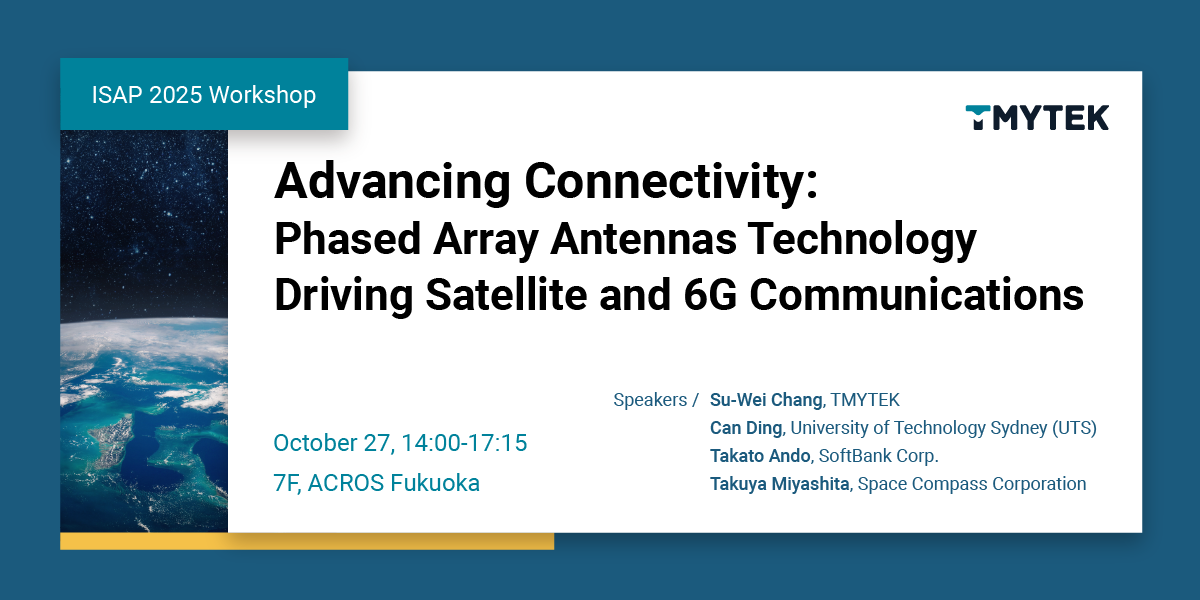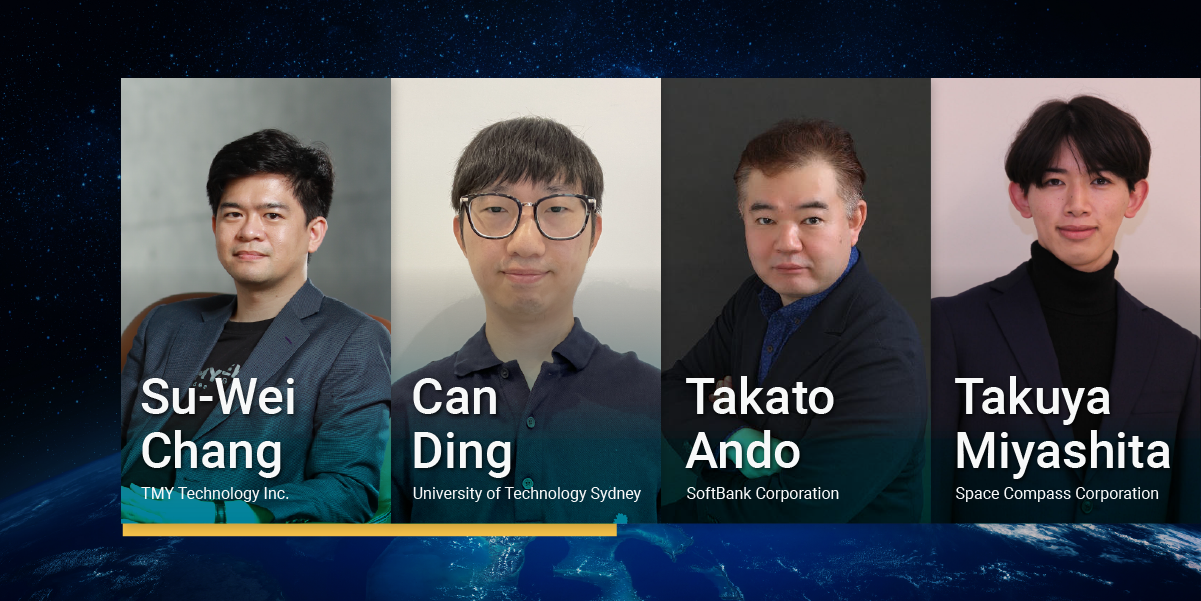ISAP 2025 Workshop | Advancing Connectivity: Phased Array Antennas for 6G Networks, NTN & SATCOM

TMY Technology Inc. (TMYTEK) is pleased to invite you to the ISAP 2025 Workshop, where we will explore the future of connectivity driven by phased array antenna technologies.
Under the theme “Advancing Connectivity: Phased Array Antennas Technology Driving Satellite and 6G Communications”, the workshop will cover 6G networks, Non-Terrestrial Networks (NTN), and SATCOM antenna design and system integration. The discussions will span from academic research and scientific innovation to industrial applications, offering a comprehensive view of key challenges and emerging opportunities.
We are honored to feature distinguished speakers from academia and industry:
- Su-Wei Chang · TMY Technology Inc. (TMYTEK)
- Can Ding · University of Technology Sydney (UTS)
- Takato Ando · SoftBank Corp.
- Takuya Miyashita · Space Compass Corporation
Date: Monday, October 27, 2025
Time: 14:00–17:15 (including a 15-minute break)
We warmly welcome researchers, engineers, and industry professionals to join us in discussing how phased array antenna technology is shaping seamless connectivity for 6G and satellite communications.

Abstract
Phased array antennas and advanced beamforming technologies are reshaping the future of communication systems, providing scalable and efficient solutions for multi-orbit satellite communication and 5G networks. This workshop will explore these technologies' pivotal roles, from theoretical foundations to practical implementations, highlighting their impact on connectivity advancements.
The session will cover from fundamentals of mmWave beamforming to multi-orbit satellite antenna design, including applications like Printed antennas like Reflector, Reconfigurable Intelligent Surfaces (RIS) , and cutting-edge multi-orbit satellite antennas. Practical deployment scenarios will be demonstrated using tools such as NI's USRP/X410 and Allbesmart's OAIBOX for FR2 network coverage and MIMO. Additionally, participants will delve into advanced satellite communication systems encompassing GEO, MEO, and LEO architectures, as well as emerging applications in High Altitude Platform Systems (HAPS), UAVs, and autonomous sensing.
Designed for researchers, engineers, and students, this workshop provides a comprehensive platform for engaging with the latest breakthroughs in phased array antennas and beamforming technologies. Attendees will gain valuable insights into leveraging these innovations to overcome communication challenges and drive the future of multi-orbit satellite and 5G connectivity.
Session 1. Phased Array Antennas and Beamforming Technologies for 6G Network and SATCOM
Speaker: Su-Wei Chang, Founder & President, TMYTEK
Modern communication systems demand advanced technologies to deliver high-speed, reliable, and scalable connectivity. Phased array antennas and sophisticated beamforming techniques have become essential in addressing these challenges, particularly in multi-orbit satellite communication (HAPS, GEO, MEO, and LEO) and 6G networks. These innovations enable precise signal directionality, ensuring seamless coverage while overcoming interference and capacity constraints.
This workshop offers participants a comprehensive understanding of phased array antennas and beamforming technologies, focusing on their role in transforming connectivity. It will explore advancements in mmWave beamforming, multi-orbit satellite antenna design, and their integration into 5G/6G systems. Practical applications, including printed antenna, Reflector, Reconfigurable Intelligent Surfaces (RIS), advanced satellite antennas, and network deployment tools like NI's USRP X410 and Allbesmart's OAIBOX for FR2/FR3 ORAN and MIMO systems, will also be covered.
By combining theoretical insights with practical applications, the workshop aims to equip researchers, engineers, and students with the knowledge to innovate and contribute to these rapidly evolving fields, shaping the future of communication systems.
Session 2. Managing Interference in Multi-Band Shared-Aperture Antenna Arrays for Future Telecommunication Infrastructures
Speaker: Can Ding, Professor, University of Technology Sydney (UTS)
From 2G to 3G, 4G, 5G, and now moving towards 6G, we face an increasing number of frequency bands and standards to support, as well as a growing number of connected devices. In 6G, we must not only enhance the traditional terrestrial network but also integrate non-terrestrial networks, connecting ground users to UAVs, airplanes, and even satellites. This shift presents significant challenges for antenna systems in telecommunication infrastructure and modern vehicles. To meet these demands, antenna collocation and shared-aperture with various polarizations and frequency bands designs are essential. This approach optimizes spectrum utilization, bolsters spectral efficiency, and facilitates multi-band communication. It also empowers efficient space utilization, cost-effectiveness, and the adaptability of communication systems to evolving technology and spectrum demands.
However, antenna collocation introduces significant challenges, primarily in the form of substantial self- and mutual interference among the antennas. This interference can lead to performance degradation in critical parameters such as antenna matching, isolation, and radiation patterns. Such performance deterioration can have a cascading impact on the overall communication system, affecting its effectiveness and reliability. Consequently, effectively managing and mitigating interference represents a pivotal aspect of successful antenna collocation in complex communication environments. This talk will focus on mitigating various interference among antenna arrays by developing electromagnetically uncoupled antenna elements.
Session 3. Multi Antenna Technology & SDMA for Beyond 5G
Speaker: Takato Ando, Technical Meister, SoftBank Corp.
The real capacity of 5G and Next Gen. RAN lies in multi-antenna systems that enable Spatial Division Multiple Access (SDMA). While Massive MIMO has become a common term, true SDMA deployment remains limited, and improving power efficiency is still essential. Millimeter-wave spectrum, though not yet widely adopted, must be mastered as a critical step toward Next Gen. RAN. Ultimately, millimeter-wave systems should also evolve into SDMA.
This presentation highlights the path to unlocking super capacity in Next Gen. RAN through SDMA-enabled multi-antenna technologies with energy efficiency for Next Gen.Mobile technology.
Session 4. Phased-Array Antennas for a Space Integrated Computing Network (GEO/LEO/HAPS): Effectiveness and Operator Insights
Speaker: Takuya Miyashita, Communications Engineering, Space Compass Corporation
This presentation demonstrates the effectiveness of phased-array antennas as an indispensable enabler for a Space Integrated Computing Network in which GEO, LEO, and HAPS cooperate to address societal challenges. The objectives are to outline two pillars—(i) a Space Data Center that unlocks the full value of Earth-observation data and (ii) a Space RAN that supplements and extends terrestrial communications—and, with emphasis on the Space RAN, to compare GEO/LEO/HAPS infrastructures and the antenna capabilities they require. Methods combine operator-oriented requirements analysis (multi-orbit compatibility, multi-band operation, SWaP optimization, portable gateways) with architectural synthesis and deployment evidence. We share operational insights from maritime connectivity using phased array antennas and summarize ongoing developments of a portable HAPS gateway and a regenerative payload, including key integration choices and performance targets. Results show that phased arrays overcome the mass, volume, and mechanical-steering constraints of legacy parabolic antennas, enabling rapid beam agility and compact, rugged form factors across multi-orbit, multi-band NTN scenarios. We relate these properties to improved portability, reliability, and maintainability, and to anticipated gains in link availability with HAPS backhaul. These findings position phased-array technology as a primary driver of satellite and 5G communications across GEO, LEO, and HAPS, informing operator design choices and accelerating the realization of a multi-orbit Space RAN.